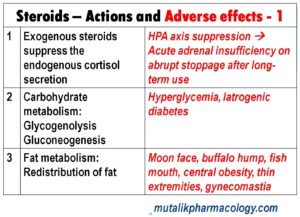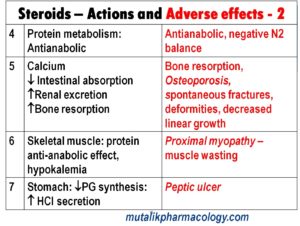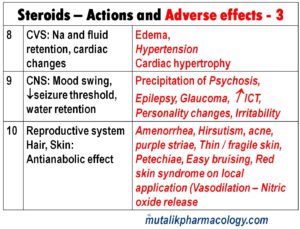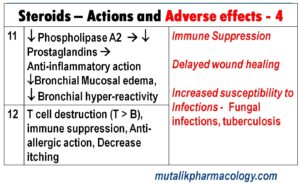Corticosteroids
Corticosteroids include steroid hormones including glucocorticoids which have predominant effects on glucose, protein, and fat metabolism, and also have anti-inflammatory action. Mineralocorticoids means those steroids who have predominant effects on minerals (salt and water metabolism).
SAQ/Viva
What is HPA axis and the negative feedback mechanism in the HPA axis?
HPA means Hypothalamo – Pituitary – Adrenal.
HPA axis is the Hypothalamo-Pituitary-Adrenal Axis. This is the axis through which the corticosteroids are seccreted.
Hypothalamus secrets ACTH-RH (AdrenoCrticoTropic Hormone – Releasing Hormone) (Same as CRF -Corticotropin Releasing Factor). This stimulates the pituitary gland to secrete ACTH (AdrenoCrticoTropic Hormone) or Corticotropin. ACTH/Corticotropin acts on the Adrenal cortex to secrete corticosteroids.
There exists a negative feedback mechanism in this axis.
When steroids become more, there goes a negative feedback signal to hypothalamus to decrease ACTH-RH and also to pituitary to decrease the release of ACTH…..Thus the secretion of steroids from Adrenal cortex can be controlled.
Reverse happens when the steroid levels are low. Low steroid levels stimulate the secretion of ACTH-RH from hypothalamus and that of ACTH from the pituitary; and there goes a signal to the Adrenal cortex, which then increases the secretion of steroids.
SAQ/Viva
What is suppression of HPA axis? What are its implications?
HPA axis is the Hypothalamo-Pituitary-Adrenal Axis. This is the axis through which the corticosteroids are seccreted.
High levels of steroids send a negative feedback signal to hypothalamus to decrease ACTH-RH and also to pituitary to decrease the release of ACTH; due to which the steroid secretion by Adrenal cortex is decreased.
Similarly, low steroid levels send a signal to Hypothalamus to increase the ACTH-RH and also to pituitary to increase the ACTH secretion, which in turn helps the Adrenal cortex to increase the steroid secretion.
On the background of the above feedback mechanism that normally exists in our body ——
If someone consumes steroids for long time, slowly the blood level of steroids keeps increasing, which by negative feedback mechanism suppresses the levels of ACTH-RH from Hypothalamus and that of ACTH from Pituitary. This slowly produces decreased secretion of endogenous steroids from Adrenal cortex. Hence this is called suppression of HPA axis.
Thus this individual depends on the exogenous steroids which he is consuming every day. If for any reason, this individual stops taking steroids abruptly, then because there is no time for the tissues to regain the suppressed HPA axis function, the individual can suffer from Acute Adrenal Insufficiency, a potentially dangerous condition of deficiency of steroids. Thus abrupt stoppage/cessation of the long-term steroid treatment can be dangerous.
Implications of HPA axis suppression:
- HPA axis suppression happens due to long term steroid treatment; hence the abrupt cessation/stoppage of long-term steroid treatment can lead to acute adrenal insufficiency.
- So, if steroids are being given to a patient for long period of time, the steroid treatment should not be stopped abruptly.
- Long-term steroids should be slowly tapered over long period, and then stopped.
- Unless extremely essential, steroids should not be used for long time.
LAQ/SAQ/Viva
Mention pharmacological actions and adverse effects of steroids/corticosteroids/glucocorticoids.
Following 4 tables describe the actions on the left side and the related adverse effect on the right column. It becomes easy to learn the action and related adverse effect together.




SAQ/LAQ/Viva
Mention the life saving indications for corticosteroids.
Corticosteroids are useful in severe, acute conditions. Some of the conditions are as follows:
- Acute anaphylactic shock
- Status asthmaticus
- Acute adrenal insufficiency
- Neonatal Acute respiratory distress syndrome
- Cerebral edema
- Acute necrotizing vasculitis
- Acute hypercalcemia
- Circulatory collapse
- Septic shock
- Water intoxication
- Central hyperthermia
SAQ/LAQ/Viva
Mention the therapeutic uses of corticosteroids.
A. Pharmacotherapy (Drug treatment of various conditions)
- Allergic conditions: Anaphylactic shock, angioneurotic edema, serum sickness, allergic dermatitis, allergic rhinitis, allergic conjunctivitis
- To prevent graft rejection
- Collagen diseases: Systemic lupus erythematosus, polyarteritis nodosa, dermatomyositis, vasculitis, glumerulonephritis
- Autoimmune conditions: Autoimmune hemolytic anemia, Idiopathic thrombocytopenic purpura, chronic active hepatitis, myasthenia gravis, nephrotic syndrome, lepra reactions
- Respiratory conditions: Neonatal respiratory distress syndrome, aspiration pneumonia, Severe chronic bronchial asthma, status asthmaticus, acute exacerbation of asthma
- Skin diseases: Eczema, chronic dermatitis, lichen planus, pemphigus, psoriasis, exfoliative dermatitis, Steven-Johnson syndrome
- Malignancies: Acute lymphocytic leukemia, Hodgkin lymphoma, other lymphomas
- Arthritic conditions: Osteoarthritis, acute non-responding gout, rheumatic fever, rheumatoid arthritis
- Eye diseases: Optic neuritis, uveitis, allergic conjunctivitis/iritis/iridocyclitis
- Intestinal diseases: Severe ulcerative colitis, Crohn disease, celiac disease
- Bell’s palsy, Multiple sclerosis, Thyroid storm
- LIfe-saving indications including anaphylatic shock, circulatory collapse, cerebral edema, status asthmaticus, neonatal acute respiratory distress syndrome, acute hypercalcemia, water intoxication etc..
(B) Replacement therapy
- Addison disease
- Acute adrenal insufficiency
- Congenital adrenal hyperplasia
SAQ/Viva
Classify corticosteroids with examples.
[A] Glucocorticoids
*Short acting: Cortisone, hydrocortisone
*Intermediate acting: Prednisone, methylprednisone, triamcinolone
*Long acting: Dexamethasone, betamethasone, deflazacort
[B] Mineralocorticoids
*Desoxycorticosterone acetate, Fludrocortisone, Aldosterone
SAQ/Viva
What do you mean by check-list for steroids. Mention the check list.
The conditions in which steroids should not be given or should be given very cautiously is called the check list for steroids. These conditions may not be always absolute contraindications for using steroid in a single dose or on a very short term basis; but long term use of steroids in these conditions should be avoided, because these conditions are aggravated or precipitated by steroids.
The check list for steroids includes:
1.Diabetes mellitus
2.Hypertension
3. Peptic ulcer
4. Osteoporosis
5. Epilepsy
6. Psychosis
7. Glaucoma
8. Pregnancy
9. Heart failure
10. Severe renal dysfunction
11. Tuberculosis/Active infections
12. Immunodeficiency
13. Herpes simplex keratitis
It’s very helpful sir.. Thank you so much